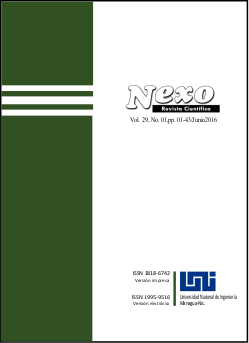STUDY OF A PROTOCOL FOR DETERMINING AUTOXIDATION IN LIPIDS OF FRESHWATER FISH PRODUCTS
DOI:
https://doi.org/10.5377/nexo.v29i01.4396Keywords:
FPC, Heme iron, Sábalo, Peroxide value, TBARAbstract
In Argentina, the species of freshwater river more abundant but without commercial value is the sábalo (Prochilodus platensis), for that reason have been developed technologies of use of this species. However, its higher lipid value compared to sea fish accelerates the oxidation process, affecting its properties and sensory quality. Here, a suitable methodological scheme will be implemented to evaluate the autoxidation in the fresh muscle of unprocessed sardine and its protein concentrate, both conserved at -20ºC, following the deterioration according to the peroxide index, compounds reactive to thiobarbituric acid and heminic iron. It was found that the determination of TBARS is more efficient the color development at boiling temperatures, and an increase in the concentration of the TBA reagent does not significantly improve the absorbance signal. The presence of cryoprotectants is a limitation to the TBARS technique, which causes significant interference. The heminic iron level presents a proportional decrease according to the incubation time and the cooking of the samples. The levels of peroxides in samples of fresh muscle and surimi are very low, implying that if conservation is controlled this deterioration is avoidedDownloads
Download data is not yet available.
Abstract
1373
1373
PDF (Español (España)) 1004
Downloads
Published
2017-07-08
How to Cite
Medina, J., Melica, A., Lorenzati, J., & Pérez, G. (2017). STUDY OF A PROTOCOL FOR DETERMINING AUTOXIDATION IN LIPIDS OF FRESHWATER FISH PRODUCTS. Nexo Revista Científica, 29(01), 14–21. https://doi.org/10.5377/nexo.v29i01.4396
Issue
Section
Articles
License
The authors who publish in Nexo Scientific Journal agree to the following terms:
- Authors retain the copyright and grant the journal the right of the first publication under the license Creative Commons Attribution License, which allows others to share the work with a recognition of the authorship of the work and the initial publication in Nexo Scientific Journal.
- Authors may separately establish additional agreements for the non-exclusive distribution of the version of the work published in the journal (for example, in an institutional repository or a book), with the recognition of the initial publication in Nexo Scientific Journal.
- Authors are allowed and encouraged to disseminate their works electronically (for example, in institutional repositories or in their own website) before and during the submission process, as it can lead to productive exchanges, as well as earlier and greater citation of published works.










